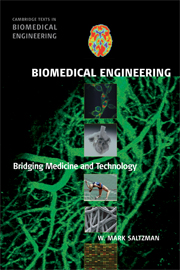Book contents
- Frontmatter
- Contents
- Preface
- Acknowledgments
- Abbreviations and Acronyms
- 1 Introduction: What Is Biomedical Engineering?
- PART 1 MOLECULAR AND CELLULAR PRINCIPLES
- PART 2 PHYSIOLOGICAL PRINCIPLES
- PART 3 BIOMEDICAL ENGINEERING
- 10 Biomechanics
- 11 Bioinstrumentation
- 12 Bioimaging
- 13 Biomolecular Engineering I: Biotechnology
- 14 Biomolecular Engineering II: Engineering of Immunity
- 15 Biomaterials and Artificial Organs
- 16 Biomedical Engineering and Cancer
- Appendix A Physiological Parameters
- Appendix B Chemical Parameters
- Appendix C Units and Conversion Factors
- Index
- Plate section
- References
13 - Biomolecular Engineering I: Biotechnology
from PART 3 - BIOMEDICAL ENGINEERING
- Frontmatter
- Contents
- Preface
- Acknowledgments
- Abbreviations and Acronyms
- 1 Introduction: What Is Biomedical Engineering?
- PART 1 MOLECULAR AND CELLULAR PRINCIPLES
- PART 2 PHYSIOLOGICAL PRINCIPLES
- PART 3 BIOMEDICAL ENGINEERING
- 10 Biomechanics
- 11 Bioinstrumentation
- 12 Bioimaging
- 13 Biomolecular Engineering I: Biotechnology
- 14 Biomolecular Engineering II: Engineering of Immunity
- 15 Biomaterials and Artificial Organs
- 16 Biomedical Engineering and Cancer
- Appendix A Physiological Parameters
- Appendix B Chemical Parameters
- Appendix C Units and Conversion Factors
- Index
- Plate section
- References
Summary
LEARNING OBJECTIVES
After reading this chapter, you should:
Understand the relationship between biomolecular engineering and chemical engineering.
Understand the concepts of drug effectiveness and toxicity, the limitations of some of the simplest methods of drug administration, and the need for controlled delivery systems that optimize therapy for a particular drug.
Understand how polymeric materials with different physical properties can be fashioned into matrix, microsphere, transdermal, and other delivery systems.
Understand how tissue engineering has emerged as a possible solution for organ replacement or healing.
Understand the biological significance of materials with nanoscale dimensions and how material scientists are learning to assemble materials that use or mimic biological principles of self-assembly.
Prelude
The early chapters of this book introduce some of the chemicals that are important in human biology. In fact, it is possible to think of the human body as an elaborate bag of chemicals. In the subspecialty called biomolecular engineering (or biotechnology), biomedical engineers examine the changes in chemical components within a biological system and develop methods for modifying these chemicals or their interactions. The concept of introducing chemicals to induce a change in a biological system is familiar; for example, we all have some experience with taking purified chemicals such as acetaminophen or ibuprofen as drugs to relieve pain. But new biological tools now make it possible to consider more complex chemical interventions such as gene therapy (in which a new deoxyribonucleic acid [DNA] sequence is introduced to allow expression of a new genetic activity).
- Type
- Chapter
- Information
- Biomedical EngineeringBridging Medicine and Technology, pp. 472 - 506Publisher: Cambridge University PressPrint publication year: 2009

